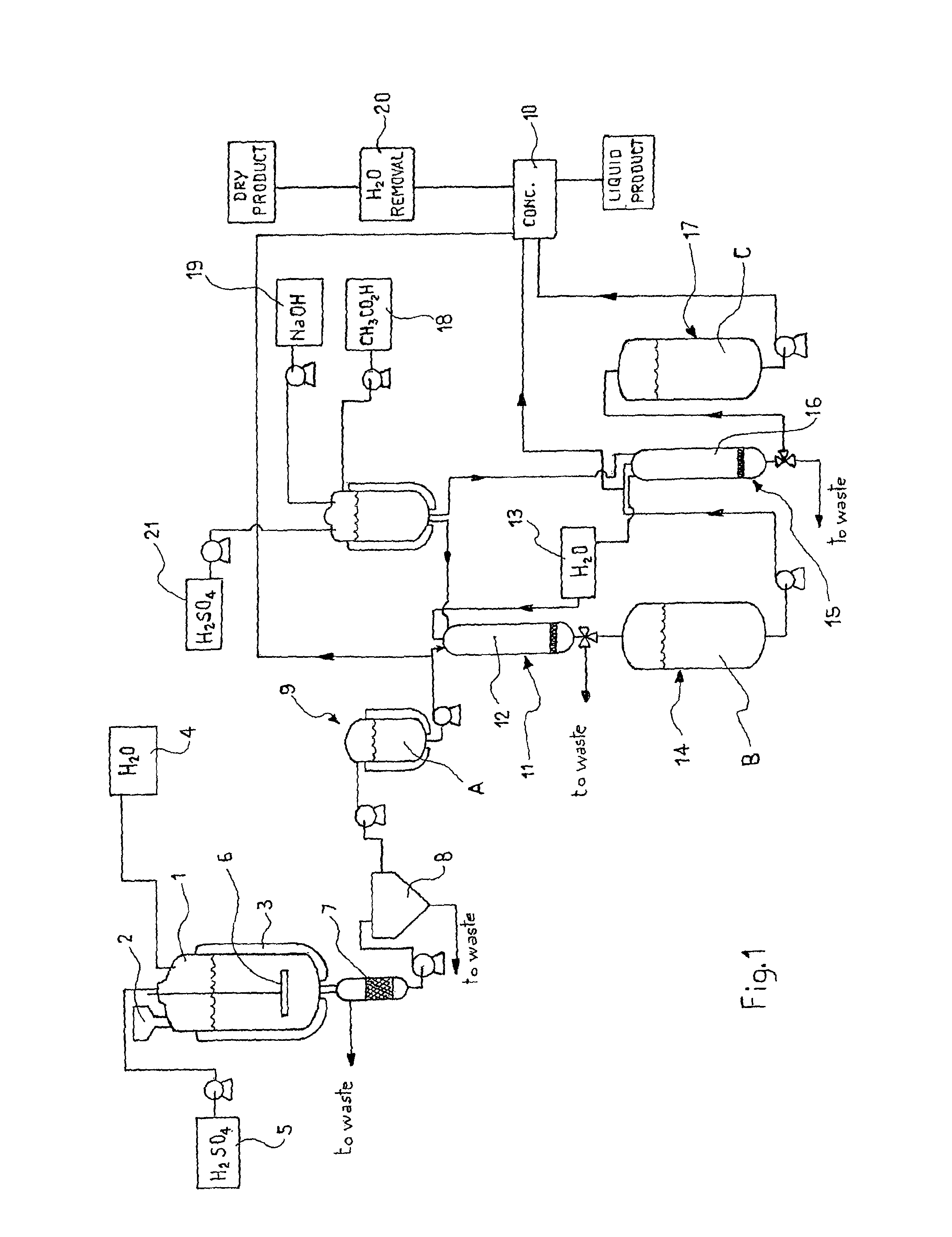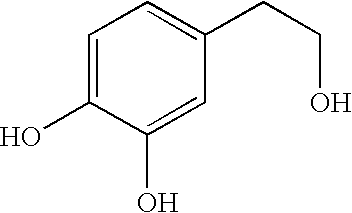Process and apparatus for the production of hydroxytyrosol containing extract from olives and solids containing residues of olive oil extraction
a technology of olive oil and hydroxytyrosol, which is applied in the field of process and apparatus for the production of hydroxytyrosol containing extract from olives and/or the solids containing olive oil residues, can solve the problems of inconvenient use of organic solvents, for example methanol, when eluting, and the generation of by-products is a much bigger problem, so as to reduce the osmotic pressure and reduce the yield
- Summary
- Abstract
- Description
- Claims
- Application Information
AI Technical Summary
Benefits of technology
Problems solved by technology
Method used
Image
Examples
example 1
Hydroxytyrosol Extraction from Olive Waste (Orujillo), Purification of the Water Phase
[0068]250 g of a sample of dry olive waste, orujillo, are mixed with 838 ml of demineralized water and 16.7 g of sulphuric acid (98%). The obtained mixture is kept in autoclave for 30 minutes at 121° C. After that, the aqueous phase is separated from the solid residue, by filtering on a filter. The solid phase, retained on the filter, is washed with 310 ml of demineralized water, and the water coming from this washing operation is collected with the aqueous phase previously recovered. The aqueous phase, approximately 860 ml, is then centrifuge refined to eliminate solid particles passed through the filter. After solid elimination, 835 ml of crude aqueous extract, containing 1.41 g of hydroxytyrosol, with a HPLC purity of 47.5%, are obtained.
example 2
Ion Exchange Hydroxytyrosol Purification
[0069]A sample of 835 ml of crude aqueous extract containing 1.41 g of hydroxytyrosol obtained according to Example 1, is loaded on a column containing a ion exchange resin of the anionic type, previously activated by means of acetate cycle. For example, Diaion WA10 may be used. The liquid phase recovered at the end of the column, does not contain any hydroxytyrosol, which is instead continuously eluted with demineralised water until at least 90% of the initially charged hydroxytyrosol is recovered. The eluted phase contains approximately 1.27 g of hydroxytyrosol with an HPLC purity of about 80.85%.
example 3
Ion Exchange and Adsorption Hydroxytyrosol Purification
[0070]A sample of 835 ml of crude aqueous extract containing 1.41 g of hydroxytyrosol obtained according to Example 1, is loaded on a column containing an ion exchange resin of the anionic type, previously activated by means of acetate cycle. For example, IRA-67 may be used. The liquid phase recovered at the end of the column, does not contain any hydroxytyrosol, which is instead continuously eluted with demineralised water until at least 90% of the initially charged hydroxytyrosol is recovered.
[0071]The eluted phase coming from the first column, is charged on a column containing an adsorption resin. For example, resin XAD-1180 may be used. The liquid phase recovered at the end of the column, does not contain any hydroxytyrosol. Then, hydroxytyrosol is eluted from the resin with demineralised water until at least 90% of the initially charged hydroxytyrosol is recovered.
[0072]The eluted phase contains approximately 1.14 g of hydr...
PUM
| Property | Measurement | Unit |
|---|---|---|
| pressure | aaaaa | aaaaa |
| temperature | aaaaa | aaaaa |
| pressure | aaaaa | aaaaa |
Abstract
Description
Claims
Application Information
 Login to View More
Login to View More - R&D
- Intellectual Property
- Life Sciences
- Materials
- Tech Scout
- Unparalleled Data Quality
- Higher Quality Content
- 60% Fewer Hallucinations
Browse by: Latest US Patents, China's latest patents, Technical Efficacy Thesaurus, Application Domain, Technology Topic, Popular Technical Reports.
© 2025 PatSnap. All rights reserved.Legal|Privacy policy|Modern Slavery Act Transparency Statement|Sitemap|About US| Contact US: help@patsnap.com



